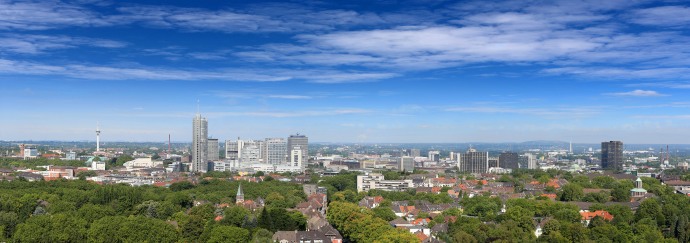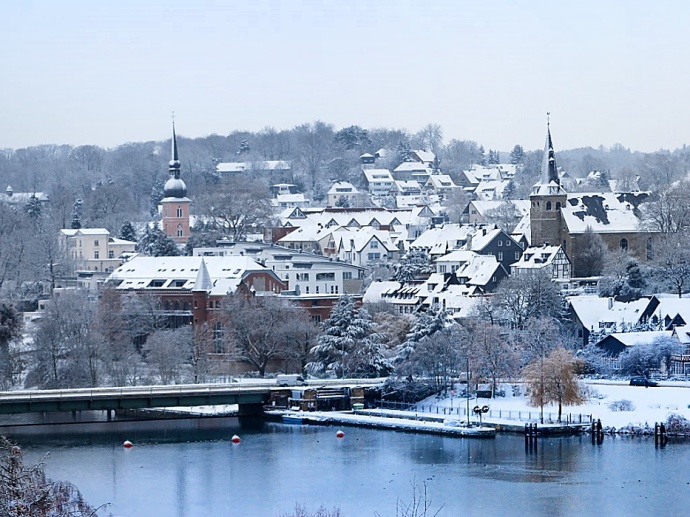 The city of Bremen, Germany’s tenth most populated city, is also the smallest of Germany’s 16 states. The city is home to the second largest port in Germany and is a commercial and industrial centre trading in cotton, wool, tobacco and copper. The city produces many goods including ships, aircrafts, steel, machinery, textiles and foodstuffs (particularly roasted coffee). It is believed that the marshes and moraines near and where Bremen stands today have been settled since approximately 12,000 BC! Today, almost one quarter of Bremen’s population are of non-German origin, with the highest non-German populations being Turkish, Polish and Bulgarian. The city has much to offer, from its historical old town (and its world-famous Town Musicians from the Brothers Grimm fairytale… but more about that later), to its interactive exhibitions and science centres, museums and the monthly fairs, markets, concerts and plays.
The city of Bremen, Germany’s tenth most populated city, is also the smallest of Germany’s 16 states. The city is home to the second largest port in Germany and is a commercial and industrial centre trading in cotton, wool, tobacco and copper. The city produces many goods including ships, aircrafts, steel, machinery, textiles and foodstuffs (particularly roasted coffee). It is believed that the marshes and moraines near and where Bremen stands today have been settled since approximately 12,000 BC! Today, almost one quarter of Bremen’s population are of non-German origin, with the highest non-German populations being Turkish, Polish and Bulgarian. The city has much to offer, from its historical old town (and its world-famous Town Musicians from the Brothers Grimm fairytale… but more about that later), to its interactive exhibitions and science centres, museums and the monthly fairs, markets, concerts and plays.
Universum Science Centre – Universum is a large science centre that opened in 2000 and turns science into a big adventure. The building itself resembles a silver whale or a giant silver mussel and contains approximately 250, mostly interactive, exhibits. The exhibits predominantly focus on mankind, the Earth and the cosmos. Some of the interactive exhibits include experiencing a tornado or discovering how obstacles can affect a man-made waterway. In recent years an outdoor EntdeckerPark discovery zone was added which features many interactive stations on the theme of movement. The museum is popular with all ages from 3 and up, so whether you’re six or sixty, this museum is for you!
 Bremer Stadtmusikanten – The Bremer Stadtmusikanten (Town Musicians of Bremen) is a Germany fairytale by the brothers Grimm and despite their name, the musicians never actually make it to Bremen. The tale follows a donkey, a dog, a cat and a rooster that have become too old to be useful to their farmers and decide to leave their homes before they are discarded by their owners… but we won’t spoil the ending for you! There is currently a bronze statue in Bremen which was erected in 1953 and if you visit it, you will notice that the donkey’s front hooves have become very shiny, as touching them is said to make a wish come true. Below are some links to this beloved fairytale:
Bremer Stadtmusikanten – The Bremer Stadtmusikanten (Town Musicians of Bremen) is a Germany fairytale by the brothers Grimm and despite their name, the musicians never actually make it to Bremen. The tale follows a donkey, a dog, a cat and a rooster that have become too old to be useful to their farmers and decide to leave their homes before they are discarded by their owners… but we won’t spoil the ending for you! There is currently a bronze statue in Bremen which was erected in 1953 and if you visit it, you will notice that the donkey’s front hooves have become very shiny, as touching them is said to make a wish come true. Below are some links to this beloved fairytale:
Fairytale (German): http://www.grimmstories.com/de/grimm_maerchen/die_bremer_stadtmusikanten
Fairytale (English): http://www.bremen-tourism.de/the-bremen-town-musicians
Full movie – 1.5 hours (German): https://www.youtube.com/watch?v=fGBeckfxeuI
Cartoon – 20 minutes (English): https://www.youtube.com/watch?v=eq4iZvP9EsY
 Schnoorviertel – The Schnoor neighbourhood is the only area in Bremen which has preserved its medieval character. The oldest buildings in the area date back to the end of the Middle Ages. There are two theories about how the area received its name: the word Schnoor is very close to the German word Schnur, meaning string. Some have suggested that the area was named Schnoor as the houses are very close together, like pearls on a string, however, the most widely accepted theory is that this part of the town used to be the old fishermen’s quarter, where the rope makers used to live and thus received the nickname Schnoor. The area is perfect for an afternoon of shopping, strolling in the sun and grabbing a bite to eat at one of the many restaurants and cafes, ranging from traditional German restaurants, to Irish, Italian and Spanish pubs and restaurants.
Schnoorviertel – The Schnoor neighbourhood is the only area in Bremen which has preserved its medieval character. The oldest buildings in the area date back to the end of the Middle Ages. There are two theories about how the area received its name: the word Schnoor is very close to the German word Schnur, meaning string. Some have suggested that the area was named Schnoor as the houses are very close together, like pearls on a string, however, the most widely accepted theory is that this part of the town used to be the old fishermen’s quarter, where the rope makers used to live and thus received the nickname Schnoor. The area is perfect for an afternoon of shopping, strolling in the sun and grabbing a bite to eat at one of the many restaurants and cafes, ranging from traditional German restaurants, to Irish, Italian and Spanish pubs and restaurants.
Fun Facts:
- The Bremer Stadtmusikanten has been interpreted many times and can now be found not only as a book, but as audio, movie, cartoon and even as a musical
- Bremen’s town hall and Roland statue are included on UNESCO’s World Heritage List
- The port of Bremen accounts for 20% of jobs in the area
- Only 15% of the area is unaffected by annual floods (the entire city is secured by dikes and draining mechanisms)
- The city’s coat of arms features a silver key on a red background – a symbol of the apostle Peter, the patron saint of Bremen’s cathedral
- Although Bremen is considered as one city/state, it is actually made up of two major districts: Bremen and Bremerhaven















Recent Comments